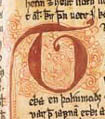 |
 |

Viking Iceland cradle of democracy About the Sagas living literature Vikings in America Project background Publication details Reviews Home |
Reviews ofThe Complete Sagas of IcelandersDanny Yee in Danny Yee's Book Reviews, 16.2: 1998"Beginning in the 9th century, settlers from Norway created in Iceland a society of fiercely independent farmers, fishermen, and traders; in the 13th and 14th centuries their descendants wrote a whole series of stories about them. These family sagas tell of feuds, duels and battles, legal conflicts, love affairs, travels and raids to Norway and the British Isles and further afield, and the attempted settlement of Vinland. The Complete Sagas of Icelanders is the first complete coordinated translation of these into English, containing all forty family sagas and fifty shorter tales. [...]In their attention to the actions of individuals within social networks, and the working through of their consequences, the Icelandic sagas are important precursors of the modern novel. They directly influenced many writers, among them Walter Scott and J.R.R. Tolkien. The sagas are also a valuable source of information about medieval Iceland, a subject of interest to more than medievalists. One of its notable features is that it had a sophisticated legal system but no executive government, which makes it a magnet for political theorists - if you search the web for information on medieval Iceland, you'll find a running fight between the libertarians and anarchists over who can best claim it as an exemplum. Some aspects of the sagas do take a little getting used to. They are episodic, sometimes covering events over several generations and jumping across decades to continue the story of a feud or the history of a region, and they alternate between periods of tension and relaxation. Characters are often introduced with a paragraph or two of genealogical information unrelated to the main story; and the sheer density of names, often shared by several characters, can be confusing. Though they never replace human actions and decisions as explanations of events, elements of foretelling and prophecy are nearly ubiquitous in the sagas. And obviously much of the cultural context is foreign to the modern reader. One soon becomes accustomed to these things, however, and overall the sagas are among the most accessible of medieval genres. Unless your library has a copy or will obtain one for you, The Complete Sagas of Icelanders is probably not practical for a newcomer to the sagas; cheap paperback editions of any of the better known ones should be easy to come by. But if you become seriously interested in the sagas - and I should warn you that they are addictive - then it's hard to go past The Complete Sagas. Firstly, the translations are good. My academic friends assure me they are mostly of high quality, accurate enough to be usable for scholarly purposes. More importantly for the lay reader, they are lively and readable, avoiding inappropriate archaism or colloquialism. The sagas are each preceded by a brief note on when they were written and their manuscript sources, but otherwise they are clean, mostly unburdened by unnecessary commentary or annotation. The only regular exceptions to this are marginal glosses for the "kennings", highly figurative stock phrases in the poetry embedded in some of the sagas, and some explanatory notes where texts are partial or put together from different sources. [...] Perhaps most importantly, this is the only uniform, coordinated translation of the family sagas available. Collecting alternative translations of them all would be a lot of work, if it is even possible, and the result would not offer as coherent a presentation of the genre. Places, characters, and events often feature in several sagas, and motifs, stock phrases, and thematic elements recur; a uniform translation scheme makes these connections easier to follow. On the other hand, the sagas do vary in style, mood, and structure, and this too is easier to appreciate when not obscured by variations in translation approach. [...] Finally, The Complete Sagas of Icelanders is beautifully produced. The leatherbound volumes find an elegant balance between attractiveness and austerity, and are of a size, shape and heft that makes reading them a pleasure (unlike some "great books" editions which are obviously designed to look impressive on shelves rather than to be read). [ << back ] |
"The riches in these volumes are thus laid before the English-reading public wherever they may be in the world." 
"On the whole, [...] The Complete Sagas of Icelanders is a work of high quality and a major addition to the resources available to the English reader who takes an interest in Old Icelandic literature. It will also be of great use to the student of Icelandic and even the scholar." 
|
 © Leifur Eiriksson Publishing Ltd.
© Leifur Eiriksson Publishing Ltd.Flokagata 65 – 105 Reykjavik – Iceland Tel: (354) 552-8989 – E-mail: vinland@centrum.is |
||